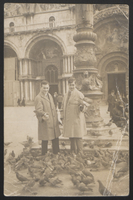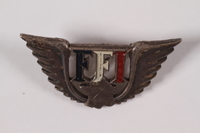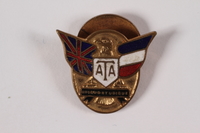Overview
- Brief Narrative
- France Forever (France Quand-Meme) laminated pin owned by Yvonne Klug Redgis, a French resistance member who was imprisoned in France and in Auschwitz concentration camp from 1943-1945. The paper pin has a graphic design with the Cross of Lorraine, a symbol of French resistance, a V for victory, and intertwined US and French flags. French Forever, the fighting French Comittee in America, was an association of French persons in the US and American friends of France who supported the Free French and provisional government. France surrendered to and was occupied by Nazi Germany in June 1940. Yvonne was arrested by the Gestapo for her resistance work on September 1, 1943, in Vichy France and sent to Drancy internment camp in October. Until June 1944, she worked as slave labor at Austerlitz train station in Paris, and then was deported to Auschwitz. She was liberated by the Soviet Army in January 1945. After recovering in a hospital, she was repatriated to France in June 1945. She emigrated to the US in 1946.
- Credit Line
- United States Holocaust Memorial Museum Collection, Gift of Ed Francell
- Contributor
-
Subject:
Yvonne Redgis
Subject: Ed Francell
- Biography
-
Yvonne Rothschild was born on January 9, 1898, in Paris, France. Her mother, Rose Marguerite Blum, was born in 1874, and her father, Alfred Rothschild, was born in 1864 in Columbus, Georgia, in the United States. She had a sister, Mariette, born in 1903. Her parents had lived in France since the 1910s. Alfred was a businessman and used the name surname Redgis professionally. Yvonne danced with the Paris Opera from the age of fifteen. She left Paris on August 19, 1922, and worked as a ballet teacher, eventually establishing her own school. In 1939, Mariette, her husband, Herbert Fraenkel, and their son, Edward, age 5, emigrated to the US. They Americanized their name to Francell.
In May 1940, Germany invaded France, and, in June, France surrendered. Yvonne worked for the Red Cross in Paris until returning that year to her home in the Riviera in the unoccupied zone, governed by the Vichy regime. On October 22, 1940, she married Henry Horace Klug, Jr., an American born in 1893, in Cavalaire-sur-Mer. Yvonne joined the French resistance and was active in destroying German propaganda. She distributed pamphlets and underground newspapers and aided men evading forced labor service to join the Maquis (guerillas), for whom she provided food. Her parents escaped by foot from France in 1942 travelling over the Pyrenees mountains into Spain. They left for the US the same year and began to use the name Redgis. On September 15, 1943, the Gestapo arrested Yvonne and Henry in Paris for their resistance work in southern France. Henri was released for lack of proof, but Yvonne was imprisoned in Toulon, partly as a hostage to keep Henry from resuming his resistance work. This made some suspect that he had turned her in to the German authorities. She was transferred to Drancy transit camp on October 9 and, on December 10, assigned as forced labor at the Austerlitz train station, a Drancy subcamp.
Yvonne was returned to Drancy on June 15, 1944. Two weeks later, on June 30, she and thirty seven other prisoners were deported on convoy 76 to Auschwitz-Birkenau concentration camp in Poland. She was tattooed with prisoner number A8616. In January 1945, she was part of a group of prisoners forced on a death march. The group was abandoned by the German guards and liberated by Soviet troops. She was held in a forced labor camp in Katowice, Poland, from February to March 15, 1945, then transferred to a hospital in Krakow. After recovering from the hardships of camp, Yvonne was repatriated to France on June 4. She was contacted by a family in Nice who told her that they had found her dog, Nicholas. When Yvonne was arrested, a Nazi soldier took Nicholas and kept the dog with him when his unit transferred south. When the family rescued him in Nice, he had been abandoned. However, he was still wearing his original collar with his name tag and Yvonne’s contact information.
In 1946, Yvonne, and Nicholas emigrated to Los Angeles where her sister had settled with her family. She was honored by the Committee of Liberation in France for resistance actions and her ordeal in Auschwitz. She divorced Henry on November 30, 1949, and changed her name to Redgis. In 1950, Yvonne was awarded a medal in Paris by the Federation Nationale des Deportes Internes Resistants Patriotes (FNDIRP), a group of survivors and former prisoners. Yvonne operated a dance studio in Santa Barbara. Beginning soon after the war, Yvonne spoke often to community groups about her war time experiences. Her father Alfred, 96, died in 1960. Her mother Marguerite, 92, passed away in 1966 in California. Yvonne, 74, died on September 3, 1972, in Santa Barbara. She had adapted her diary of her experiences into a memoir, and it was published in 2010 as Survivre: Souvenir d’une réscapée d’Auschwitz.
Edward (Ed) Fraenkel was born in Paris, France, on May 8, 1934, to Herbert and Mariette Rothschild Fraenkel. Mariette was born in 1903 in Paris to Rose Hortense Marguerite Blum, born in 1874, and businessman Alfred Rothschild, born in 1864 in Columbus, Georgia, United States. Mariette had an older sister, Yvonne, born January 9, 1898. Herbert was born December 22, 1904, in Butow, Germany, to Hermann and Gertrude Josephson Fraenkel. Gertrude was born on May 31, 1873, in Paelitz, Germany, and Herman on August 13, 1874, in Schirwindt, Germany, and they married on July 3, 1900, in Berlin. Herbert was born in 1903 and had a brother, Werner, born in 1906, both in Butow. They were raised in Danzig, where Hermann died in 1934. The family then left for France, where Herman met and married Mariette. Herbert was a textile designer. In 1939, when Edward was five, he and his parents emigrated to the United States. They arrived in New York in March and eventually settled in Los Angeles. The family name was Americanized to Francell.
After Germany invaded Poland in September 1939, Edwards's paternal uncle Werner was drafted into the French Army. In May 1940, Germany invaded France, and, in June, France surrendered. Werner, age 36, was imprisoned in Bram internment camp in France, and then, in 1942, deported to Auschwitz concentration camp in Poland and killed on August 31, 1942. Gertrude was not able to leave with Edward’s family and was hidden by a French family in Le Vesinet. On January 1, 1947, she sailed from Southhampton, England, on the SS Queen Elizabeth to join her family in the US. Edward’s maternal grandparents escaped from France to Spain in 1942, left for the US the same year, and settled in Los Angeles. Both passed away in their nineties in Santa Barbara. His maternal aunt, Yvonne Klug, was arrested for her French resistance activities and deported to Auschwitz-Birkenau. She survived the war and emigrated to the US in 1946.
Physical Details
- Classification
-
Jewelry
- Category
-
Pins (Jewelry)
- Object Type
-
Lapel pins (aat)
- Physical Description
- Rectangular, plastic laminated, white paper pin with a preprinted image of crossed red, white, and blue American and French flags with a red and white double barred Cross of Lorraine above and a blue V for Victory below. There is a wide blue border with a narrow inner red line. On the back is a spring tension pin adhered by a square plastic piece. The pin is slightly warped.
- Dimensions
- overall: Height: 2.000 inches (5.08 cm) | Width: 1.625 inches (4.128 cm) | Depth: 0.375 inches (0.953 cm)
- Materials
- overall : plastic laminate, paper, metal, ink
Rights & Restrictions
- Conditions on Access
- No restrictions on access
- Conditions on Use
- No restrictions on use
Keywords & Subjects
- Topical Term
- Guerillas--France--Biography. Ex-concentration camp inmates--France--Biography. Holocaust, Jewish (1939-1945)--France--Personal narratives. Women concentration camp inmates--Poland--Biography. World War, 1939-1945--Underground movements--France--Personal narratives. World War, 1939-1945--Prisoners and prisons, German.
Administrative Notes
- Legal Status
- Permanent Collection
- Provenance
- The lapel pin was donated to the United States Holocaust Memorial Museum in 2004 by Ed Francell, the nephew of Yvonne Redgis.
- Funding Note
- The cataloging of this artifact has been supported by a grant from the Conference on Jewish Material Claims Against Germany.
- Record last modified:
- 2023-06-13 16:10:42
- This page:
- https://collections.ushmm.org/search/catalog/irn77703
Download & Licensing
In-Person Research
- By Appointment
- Request 21 Days in Advance of Visit
- Plan a Research Visit
- Request to See This Object
Contact Us
Also in Yvonne Rothschild Redgis and Gertrude Fraenkel (Fränkel) family collection
The collection consists of pins, an audiotape, documents, memoirs, and photographs relating to the experiences of Yvonne Rothschild Klug and her family before and during the Holocaust in France, until she was deported to Auschwitz concentration camp, and after the Holocaust when she emigrated to the United States as well as correspondence, documents, and photographs relating to the experiences of Gertrude Fraenkel and her family before and during the Holocaust in France and Poland and her postwar emigration to the United States. Collection also includes a portrait of Yvonne Redgis (Rothschild).
Date: 1898-2013

Rothschild - Fränkel family papers
Document
Correspondence, official documents, photographs, and memoirs pertaining to the experiences of the maternal (Rothschild) and paternal (Fränkel) branches of the family of Ed Francell, and how they were impacted by the events of the Holocaust. Includes documents about Yvonne Redgis (Rothschild) and her life in pre-war France, during the occupation of France, as a forced laborer at Auschwitz, and her post-war immigration to the United States. Collection also contains correspondence, photographs, identification documents, and other items about the Fränkel family, originally of Danzig, and later France. Includes documentation about Gertrude Fränkel and her son, Werner, in particular about Gertrude’s experiences in occupied France and her post-war immigration to the United States, and Werner’s conscription as a forced laborer in France and his subsequent deportation to Auschwitz. The Rothschild – Fränkel family papers document the experiences of the maternal and paternal branches of the family of the donor, Ed Francell, prior to, during, and following the Holocaust. On the maternal side of the donor’s family, most of the documentation is about Yvonne Redgis (Rothschild), with photographs, personal identification documents, correspondence, and printed material focusing largely upon Redgis’ experiences as a member of the Resistance in occupied France, her arrest and deportation to Auschwitz, her repatriation to France after the war, recognition as a resistance fighter, reunion with her parents, and her immigration to the United States. Also included are photographs and a pedigree about her dog, Nicolas; and versions of her memoirs in three languages, as well as correspondence about her efforts to publish the memoirs in the United States. This memoir, originally titled “Doors That Open from the Outside” or “Le 8618 revint,” was published in France in 2010 under the title Survivre: souvenirs d’une rescapée d’Auschwitz. Documentation about the Fränkel family includes photographs and identification documents about Gertrude Fränkel, correspondence to and about the French family who sheltered her during the occupation, and documents related to her immigration to the United States in 1947. Material related to Werner Fränkel includes postcards that he sent to his mother from a forced labor camp in southern France in 1942, and postwar documents related to the family’s search for his whereabouts, and reference material about forced laborers in France, including information about the convoy to Auschwitz that included Fränkel. The collection also contains an audiocassette that may contain a copy of a recording of Yvonne Redgis speaking in 1947 at an unspecified event, a medallion with a depiction of a concentration camp and the words “N’oubliez jamais” that was presented to Redgis (“Mme. Klug”) in 1950 by the FNDIRP, and five lapel pins from various organizations, primarily related to former French resistance fighters.

FFI Free French pin engraved 193476 awarded to a Jewish resistance member
Object
FFI (Forces Francaises de l'Interieur/ French Forces of the Interior) pin awarded to Yvonne Klug by the Committee of Liberation on July 7, 1946, for her acts of resistance against the German occupiers of France. Yvonne was imprisoned for her resistance activities in France and in Auschwitz-Birkenau concentration camp from 1943-1945. FFI was a confederation of French resistance organizations. The pin is engraved with the number 193476 and features the double barred Cross of Lorraine, a symbol of the resistance. France surrendered to and was occupied by Nazi Germany in June 1940. Yvonne was arrested by the Gestapo for her resistance work on September 1, 1943, in the Riviera and sent to Drancy internment camp in October. Until June 1944, she worked as slave labor at Austerlitz train station in Paris, and then was deported to Auschwitz II. She was liberated by the Soviet Army in January 1945, hospitalized and then repatriated to France in June 1945. She emigrated to the US in 1946.

ATA (Air Transport Auxiliary) lapel badge owned by a Jewish member of the French resistance
Object
ATA (Air Transport Auxiliary) ground support staff lapel pin owned by Yvonne Klug Redgis, a French resistance member who was imprisoned in France and in Auschwitz concentration camp from 1943-1945. ATA was a multinational civilian organization of volunteer pilots that ferried British warplanes from factories to the frontlines. The pin bears the motto Unique et Ubique and features an eagle and intertwined British and French flags. France surrendered to and was occupied by Nazi Germany in June 1940. Yvonne was arrested by the Gestapo for her resistance work on September 1, 1943, in the Riviera and sent to Drancy internment camp in October. Until June 1944, she worked as slave labor at Austerlitz train station in Paris, and then was deported to Auschwitz. She was liberated by the Soviet Army in January 1945, hospitalized and then repatriated to France in June 1945. She emigrated to the US in 1946.

FNDIRP commemorative striped badge engraved 178284 owned by a French Jewish survivor
Object
FNDIRP blue and white striped pin owned by Yvonne Klug Redgis, a French resistance member who was imprisoned in France and in Auschwitz concentration camp from 1943-1945. FNDIRP (Federation Nationale des Deportes et Internes, Resistances et Patriotes) is an association formed in France after the war by those who returned from the camps and those who resisted the German occupiers to honor their service and the memory of those who did not survive. The pin is engraved with prisoner number 178284 and the stripes are reminiscent of concentration camp uniforms. France surrendered to and was occupied by Nazi Germany in June 1940. Yvonne was arrested by the Gestapo for her resistance work on September 1, 1943, in the Riviera and sent to Drancy internment camp in October. Until June 1944, she worked as slave labor at Austerlitz train station in Paris, and then was deported to Auschwitz. She was liberated by the Soviet Army in January 1945, hospitalized and then repatriated to France in June 1945. She emigrated to the US in 1946.

FNDIRP blue and white striped stickpin owned by a French Jewish survivor
Object
FNDIRP blue and white striped stickpin owned by Yvonne Klug Redgis, a French resistance member who was imprisoned in France and in Auschwitz concentration camp from 1943-1945. FNDIRP (Federation Nationale des Deportes et Internes, Resistances et Patriotes) is an association formed in France after the war by those who returned from the camps and those who resisted the German occupiers to honor their service and the memory of those who did not survive. The pin has an enameled prisoner number 178284 and the stripes are reminiscent of concentration camp uniforms. France surrendered to and was occupied by Nazi Germany in June 1940. Yvonne was arrested by the Gestapo for her resistance work on September 1, 1943, in the Riviera and sent to Drancy internment camp in October. Until June 1944, she worked as slave labor at Austerlitz train station in Paris, and then was deported to Auschwitz. She was liberated by the Soviet Army in January 1945, hospitalized and then repatriated to France in June 1945. She emigrated to the US in 1946.
FNDIRP engraved commemorative medal with box awarded to a French Jewish survivor
Object
FNDIRP medal with an engraved relief and presentation box awarded to Yvonne Klug Redgis, to honor her experience as a survivor of Auschwitz-Birkenau concentration camp. Yvonne was a member of the French resistance imprisoned in France and Auschwitz II from 1943-1945. FNDIRP (Federation Nationale des Deportes et Internes, Resistances Deportes) is an association formed in France after the war by those who returned from the camps and those who resisted the German occupiers to honor their service and the memory of those who did not survive. The medal is engraved to Madame Klug and has a relief of a concentration camp. France surrendered to and was occupied by Nazi Germany in June 1940. Yvonne was arrested by the Gestapo for her resistance work on September 1, 1943, in the Riviera and sent to Drancy internment camp in October. Until June 1944, she worked as slave labor at Austerlitz train station in Paris, and then was deported to Auschwitz. She was liberated by the Soviet Army in January 1945, hospitalized and then repatriated to France in June 1945. She emigrated to the US in 1946.



